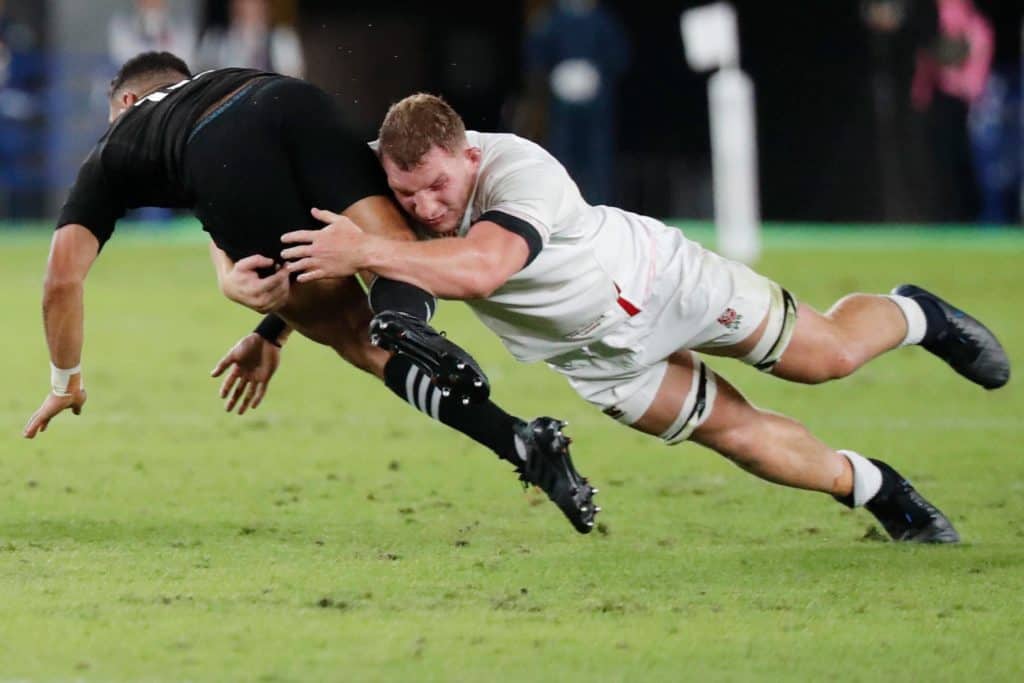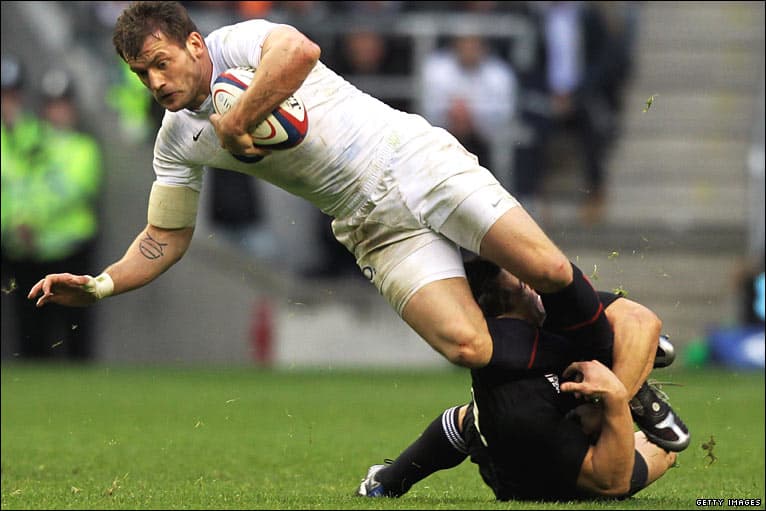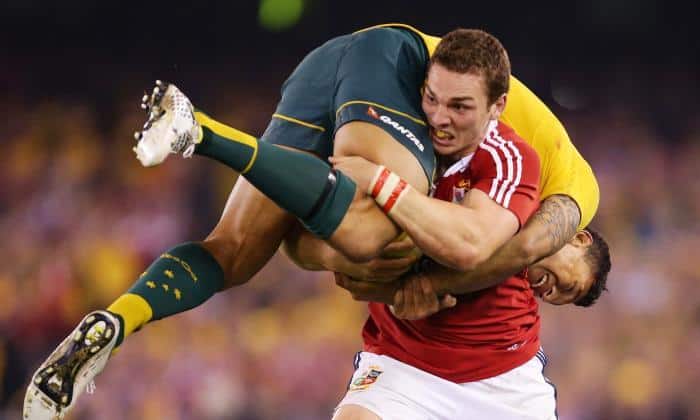
To tackle someone bigger in rugby you need drop your body height and aim lower, ideally below the knee. There is a famous saying, “no one has big ankles”. Another effective tactic to bring down a big man is to tackle from the side and quickly push up in defence to close the gap before they can start running at a high speed.
It doesn’t matter how big a rugby player is if you have got their legs wrapped up they aren’t going anywhere. This is why when you are tackling a giant you need to secure their legs. The lower you tackle the easier it becomes to control the legs.
Tackling the thighs is a good start but many rugby players have huge muscular thighs so there is a good chance you might simply bounce off if you try to make contact with your shoulder or your arms may not be long enough to wrap around and secure them.
To give you the best chance of tackling someone much bigger than yourself you need to aim for below the knee. If you can hit their shins with your shoulder and then wrap your arms around both of their lower shins and ankles they should hit the pitch pretty quickly. The key when tackling low is to drop your body height.
You need to really squat down low until your opponent’s knees are close to your eye level. From this position you should be able to launch yourself with a straight neck and back at your opponents lower leg and tackle them with ease. You also need to remember to secure both legs at the same time. A big strong player may be able to shrug off your tackle attempt if you can only get hold of one of their legs. So make sure you are wrapping up both of their legs.
When tackling a larger player you want to avoid tackling front on. If you have watched high level rugby matches you often see rampaging forwards bump off tackle attempts from players who stand square. This is not an effective tackling method for two reasons. When a defender is tackling face on the ball runner can use a technique where they thrust their forearms and knees into the tackler, this generates a huge amount of force and often sends the tackler flying.
When a defender is standing square their balance is not strong, as they have no back leg preventing them from falling backwards which they do when standing in a staggered stance. Next time you are at rugby training practice tackling a teammate running at you at high speed while in a square stance and a staggered stance to feel the difference in your balance.
Instead of trying to take on a big boy face on you should maintain your staggered stance and hit them from the side. If you tackle from the side they ball runner won’t be able to shrug you off as easily as they can’t use that forearm and knee thrust as effectively. When tackling from the side it can be a bit tricky as timing is critical.

If you go too early you will be too square and your opposition can bump you off. If you go too late your opposition will fly past you and you won’t be able to make effective contact. You need to wait until they are within touching distance and then just as the ball runner thinks they are going to fly right past you drop your level, hit their lower leg with your shoulder and wrap both of their legs up, sending their hopes of scoring a try crashing and burning.
It may seem counterintuitive but when facing off against a large opponent on the rugby pitch you need to aggressively push up in defence. You can not wait until your opposition has caught the ball and started getting ahead of steam up. The faster an opposition player is running the harder it is to tackle them because it is going to require more force to bring them down. Think about it: who would you rather tackle a player jogging towards you? Or a player sprinting at maximum speed?
Even though it may be a little scary to make it easier on yourself as soon as you see the hulking player is about to catch the ball sprint towards him if you can put a hit on him just as he is catching the ball you should have no problem sending him flying to the pitch. Action is often much better than reaction and that is definitely the case when trying to tackle a beast.
How Do I Stop Being Scared Of Rugby Tackling?

To stop being scared of rugby tackling you need to develop experience. If you have made thousands of tackles you are unlikely to be afraid. You need to build your skills, if you have great technique you will be confident in contact. Finally you need to develop your body, if you are tackling people you are bigger than you won’t be worried.
Don’t worry if you are a bit afraid of tackling during rugby. It is a common feeling that many new players deal with. It can easily be overcome through a few methods which I will explain to you.
Humans are often scared when they find themselves in situations where they lack experience. If you have never been skiing before it is only natural to feel a bit worried when you start going up a huge mountain and people tell you about all the possible injuries you could suffer. It is the same with rugby. If you haven’t made many rugby tackles in your career, particularly full contact where a big player is sprinting towards it’s totally normal to be scared.
This fear will disappear the more you play rugby. After playing the sport for a few years you will have made thousands of tackles. You will have tackled people of all shapes and sizes and found yourself putting on hits in a variety of situations.
After you have developed this experience you will realise that tackling is not something to worry about, it doesn’t hurt that much and the chance of injury is low. Typically the worst thing that will happen will you will feel a bit embarrassed if you miss an easy tackle. If you are a bit scared of tackling just keep playing this fear will fade as you become more comfortable playing footy.

You can quickly overcome your fear of tackling by turning yourself into a tackling machine. The more skilled you are, the less fear you will experience. If you become a tackling expert not only will you not be scared of tackling but you will look forward to showing off your ability everytime a ball runner makes the mistake of taking you on in the defensive line.
To improve your tackling ability you need to do lots of drilling. You need to start with no contact drills to get your body position correct. Then progress to more and more contact heavy drills until you are ready to make full contact tackles.
Your coach should be studying your tackling technique and giving you regular feedback that you need to incorporate into your technique. If you are training multiple times a week under a good coach you should be able to progress quickly and it won’t be long before you are a confident tackler.
Some General Tips When Tackling:

Drop your body height – squat down, load up your legs ( this is where your power comes from), straight back, straight neck, look slightly up
Staggered Stance – one foot in front of the other, weight on the ball of your back foot
Get your front foot close to your opposition – you want your front foot as close to the ball runner as possible, this will allow you generate maximum power
Drive off your back foot – push off your back foot hard, like the start of a running race
Hit hard with your shoulder – slam your shoulder into your opposition, anywhere from the lower rib cage to their knees is ideal, as you hit keep your legs moving, drive them back
Wrap your arms around opposition’s legs – secure both of their legs with your arms, keep driving with your legs until they fall over, make sure you take them down to side which opposite to where your head is located, you don’t want some giant falling on your face
Another factor that can help you improve your tackling confidence is bulking up. If you are on the small side and you are constantly tackling people way bigger than you then of course you are going to be scared. To make your nerves calm down, consider putting on some size.
You should eat a calorie surplus (+300 calories over maintenance) consisting of high protein foods such as eggs, red meat and chicken, you should aim for 1 gram of protein per pound of body weight. You combine this diet with 3 gym sessions a week where you focus on the big 3 (bench, deadlift and squat) you will put on some quality muscle which will make it much easier for you to tackle.
Conclusion
The best method to tackle a larger opponent on the rugby pitch is to hit lower than usual. You need to make contact below the knee and aim to wrap up your opposition’s ankles. You also want to avoid tackling head on and not give the ball runner any space by rushing up in defence to prevent them getting into top gear. If you are scared of tackling, don’t worry this fear disappears quickly as you get some more experience, improve your skills and put on a bit of size.
